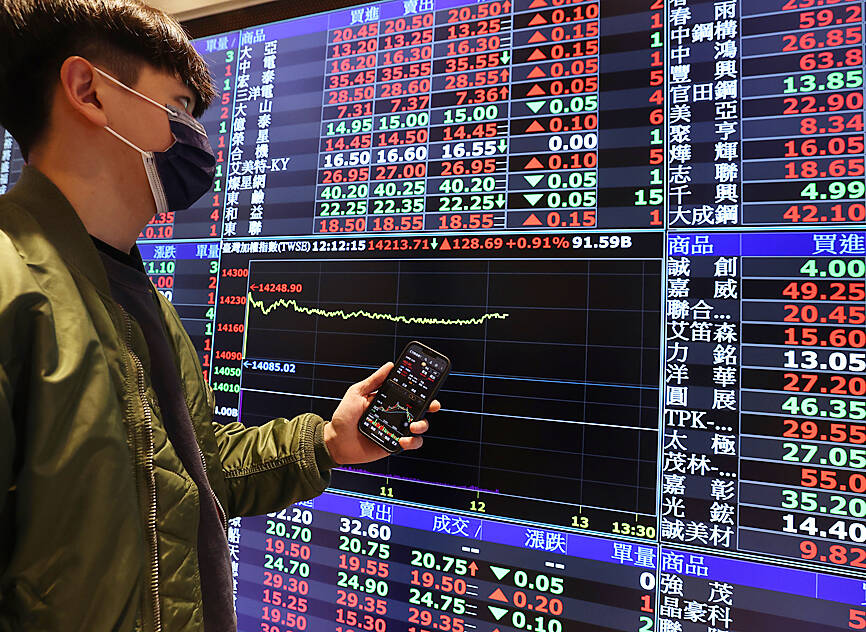Investors might take heart from the latest twist in the presidential race, as a tie-up of opposition candidates raises the odds of a more China-friendly government taking post next year.
The benchmark TAIEX rose on Wednesday and the New Taiwan dollar advanced, as traders digested the announcement that the Chinese Nationalist Party (KMT) and the Taiwan People’s Party (TPP) would put forward a united candidate. That came as a relief for some who have been worried about a potential deterioration in cross-strait relations should Vice President William Lai (賴清德), the Democratic Progressive Party’s (DPP) presidential candidate, who has consistently led opinion polls, win.
Geopolitical risks have been an overhang over Taiwanese equities for years, with investors fretting over the possibility of a military conflict between Taipei and Beijing. While the TAIEX has rallied more than 20 percent this year as an artificial intelligence (AI) boom buoyed chip giants, foreigners are on track for a fourth straight year of outflows.

Photo: CNA
“It gives us a sense of temporary relief on the election uncertainty,” said Xiadong Bao, a fund manager at Edmond de Rothschild Asset Management in Paris. “The alliance raises the potential for further dialogues to improve cross-strait relations.”
Voters going to the polls on Jan. 13 are to choose between a ruling party determined to maintain Taiwan’s sovereignty, and an opposition that sees closer ties with China as the only viable path. The outcome would define Taipei’s relations with Beijing in the years to come, while also setting the tone for US-China tensions.
Then-US House of Representatives speaker Nancy Pelosi’s visit to Taipei in August last year raised angst in financial markets, as Beijing ratcheted up military drills around Taiwan in a show of warning. The TAIEX fell 1.6 percent in the session before Pelosi met President Tsai Ing-wen (蔡英文), but posted small gains on the day.
“Taiwan market volatility tended to rise in the six months leading up to the presidential elections,” Goldman Sachs Group Inc strategists including Alvin So (蘇瑋忠) wrote in a note. “Taiwan equities have shown greater performance in the three months following a KMT victory, while underperforming significantly after a DPP victory.”
While the election remains a key focus, the Taiwanese market is also affected by an array of factors, including the US monetary policy, as well as semiconductor and AI cycles.
A potential dovish pivot by the US Federal Reserve might drive more inflows into emerging markets, with such expectation on full display on Wednesday following a softer-than-expected US inflation report.
The local currency on Wednesday rose the most since July after sliding more than 4 percent this year, hammered by a large rate differential with the US and equity outflows. The TAIEX closed up 1.3 percent.
Wednesday’s announcement by the opposition “should be broadly positive for Taiwanese and Chinese assets, especially when considered in conjunction with improving US-China relations,” said Rory Green, China economist at TS Lombard.
Sectors most exposed to cross-strait trade, including semiconductor companies, agriculture producers and tourism-related firms stand to benefit, he added.

Taiwan’s exports soared 56 percent year-on-year to an all-time high of US$64.05 billion last month, propelled by surging global demand for artificial intelligence (AI), high-performance computing and cloud service infrastructure, the Ministry of Finance said yesterday. Department of Statistics Director-General Beatrice Tsai (蔡美娜) called the figure an unexpected upside surprise, citing a wave of technology orders from overseas customers alongside the usual year-end shopping season for technology products. Growth is likely to remain strong this month, she said, projecting a 40 percent to 45 percent expansion on an annual basis. The outperformance could prompt the Directorate-General of Budget, Accounting and

The demise of the coal industry left the US’ Appalachian region in tatters, with lost jobs, spoiled water and countless kilometers of abandoned underground mines. Now entrepreneurs are eyeing the rural region with ambitious visions to rebuild its economy by converting old mines into solar power systems and data centers that could help fuel the increasing power demands of the artificial intelligence (AI) boom. One such project is underway by a non-profit team calling itself Energy DELTA (Discovery, Education, Learning and Technology Accelerator) Lab, which is looking to develop energy sources on about 26,305 hectares of old coal land in

Netflix on Friday faced fierce criticism over its blockbuster deal to acquire Warner Bros Discovery. The streaming giant is already viewed as a pariah in some Hollywood circles, largely due to its reluctance to release content in theaters and its disruption of traditional industry practices. As Netflix emerged as the likely winning bidder for Warner Bros — the studio behind Casablanca, the Harry Potter movies and Friends — Hollywood’s elite launched an aggressive campaign against the acquisition. Titanic director James Cameron called the buyout a “disaster,” while a group of prominent producers are lobbying US Congress to oppose the deal,

Two Chinese chipmakers are attracting strong retail investor demand, buoyed by industry peer Moore Threads Technology Co’s (摩爾線程) stellar debut. The retail portion of MetaX Integrated Circuits (Shanghai) Co’s (上海沐曦) upcoming initial public offering (IPO) was 2,986 times oversubscribed on Friday, according to a filing. Meanwhile, Beijing Onmicro Electronics Co (北京昂瑞微), which makes radio frequency chips, was 2,899 times oversubscribed on Friday, its filing showed. The bids coincided with Moore Threads’ trading debut, which surged 425 percent on Friday after raising 8 billion yuan (US$1.13 billion) on bets that the company could emerge as a viable local competitor to Nvidia